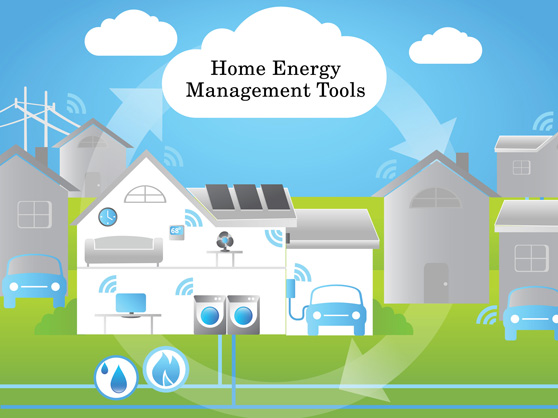By: Larry Cochrane, Microsoft Corporation and Scott Neumann, Utility Integration Solutions
Desire for energy independence and cleaner energy sources along with the growing interest in climate change are driving a fundamental shift toward the use of smart technologies such as meters. At the same time, smart technology brings on numerous first-time issues for utilities. How do utilities interact with customers as they become active participants within this ecosystem? How will utilities and customers take advantage of capabilities service providers offer? How do they use and secure the exploding volumes of data? These issues will continue to grow.
Utilities face three main challenges:
1) successfully completing smart grid initiatives;
2) taking advantage of new opportunities a smart energy ecosystem enables; and 3) doing it all while still keeping the lights on.
Achieving all three is not an easy task. For most utilities, it means simultaneously deploying smart meters and launching programs such as demand response, tiered pricing and price sensitive load response without wavering on reliability. They also have to determine each program’s effectiveness and profitability. While utilities may have programs in place and are progressing faster on the commercial and industrial side, achieving the depths required for the consumer side is more complex. No single utility or industry solution provider can achieve all three without help.
Integration is the key to smart grid success. By integration, we mean connecting business processes, data, software and human interaction. This connectivity must take place across the entire smart energy ecosystem – from generation to transmission, across to distribution and all the way to consumption.
Demand response extends to wholesale markets
Integration of the retail segment with wholesale markets will be significant. If time-varying retail electricity prices are not directly linked to real-time wholesale prices, then retail consumers will not react to the right signals. According to Stu Bresler, vice president of market operations and demand resources for PJM Interconnection, one of PJM’s roles as a regional transmission organization is ensuring that wholesale prices are transparent, stable and rational. “Price transparency is key so that time-varying retail rates use real-time wholesale prices to stimulate retail customers’ responses in a way that’s consistent with grid conditions,” Bresler said.
To do this, PJM works continuously with its members, other stakeholders, federal regulators and state utility commissions to ensure wholesale market rules efficiently facilitate competition and wholesale prices accurately reflect supply and demand balance. “Connectivity and automation allows us to integrate more types of generation and storage while maintaining reliability and price stability,” he said.
PJM Interconnection also recently completed one of the largest and most sophisticated demand response software system deployments in the world for its wholesale electricity markets. The new system expands its demand-side resources and improves demand-side operational efficiency by linking and automating wholesale powermarket transactions that involve PJM, utilities and demand response curtailment service providers.
“Price transparency is key so that time-varying retail rates use real-time wholesale prices to stimulate retail customers’ responses in a way that’s consistent with grid conditions.”
– Stu Bresler, Vice President of Market Operations & Demand Resources, PJM Interconnection

Home energy management tools enable active and convenient consumer participation in the smart grid for the first time.
Smart grid reaches all the way to the customer
The smart grid extends into the premise bringing utilities closer to customers than ever. While the commercial side may be more open to direct utility control, more and more consumers will actively participate in decisions. And, they’ll make more informed energy consumption choices by following utilities’ pricing signals and using device and Internet-based home automation tools. Most consumers won’t limit themselves to services through their utility’s advanced metering infrastructure (AMI) when they can have Internet access and make decisions by setting up a predefined preference profile, for example.
What does this mean for utilities that typically want to own their customer relationships? Utilities should seek out and offer things like home energy management tools for their customers. Then utilities can complement these tools with their own services to help customers use energy in smarter ways. They can also add services such as solar panel installations, replacing major appliances or insulation upgrade programs. First, utilities have to achieve the integration needed to manage these new things.

A man works atop a wind turbine at the Delaware Mountain Wind Farm in Culberson County, Texas. Zero carbon sources amplify the need for effective enterprise-wide integration.
Distribution management drives integration
In Microsoft Worldwide Utility Industry Survey 2010, 70 percent of utility executives responding said the most important technology for successful smart grid implementations is distribution management. Smart metering came in second at 64 percent, followed by integration of renewable energy sources into the smart grid at 43.5 percent.
These statistics confirm that the real challenge is managing data flow, processes and workflow at the distribution level as utilities move toward zero-carbon energy sources. More electric vehicles hitting the roadways will intensify the challenge – and no utility can precisely predict when, where or how many electric vehicles they’ll have to support.
BC Hydro recently started its distribution management system implementation. While only in early stages, Vidya Vankayala, BC Hydro’s chief IT architect believes the new system will help ensure their customers have a safe, secure and reliable energy supply. “Since we provide power to 1.8 million customers – the majority of British Columbia – there is a tremendous responsibility to look to their future needs. We believe this DMS will help to manage new initiatives like renewables and distributed generation,” he said.
“Since we provide power to 1.8 million customers – the majority of British Colum-bia – there is a tremendous responsibility to look to their future needs. We believe this DMS will help to manage new initiatives like renewables and distributed generation.” – Vidya Vankayala, Chief IT Architect, BC Hydro
While wind and solar farms are relatively easy to construct as compared with coal, nuclear, gas or hydro plants, matching load with variable sources and ensuring reliability is very complex, and takes a lot of units to match size and capacity. To ensure the lights remain on, these distributed generation sources require storage, sophisticated energy balancing as often as every minute, and transmission enhancements to transport power.
As utilities adopt more renewable sources, integrating real-time decision tools also become more important. Since renewables do not provide reliable capacity, grid operators need the ability to predict availability and respond to unavailability better. Real-time decision tools provide information that guides workers to a more optimal and fiscally and socially responsible generation mix.
Utilities must also consider that it takes more than units and geographical diversity to generate wind or solar power. No matter how many units are built at sites like State Line in the Pacific Northwest’s Columbia River Gorge where units are highly correlated, when the wind dies, it dies for all.
Too much dependence on renewable sources can also have adverse effects. For example, tariffs in Germany make wind power desirable. However, with the use of wind, base-loaded units such as gas and coal have to be put offline, an expensive process. As a result, generators offer negative price energy bids to guarantee their base-load units remain running until the next day when they will be needed again. Some believe the net effect is higher energy usage. However, if significant demand can be shifted to the nighttime when wind is often most abundant, utilities can achieve considerable efficiencies.
The case for integrating it all – from fuel source to home
More than half of the respondents to the Microsoft survey say their utility hasn’t yet started a smart grid initiative – even at the planning stages. And more than 90 percent of respondents believe their utility’s technology architecture is not adequate to support new business processes and technologies. This says there’s still a lot of work to be done.
In fact, the Microsoft survey revealed 36 percent of respondents anticipate their organizations will need to be completely restructured if the vision of a fully integrated smart grid occurs. For example, if 30 percent of a city’s residents install rooftop solar panels, utility revenue would potentially drop by 30 percent. Since utilities may be major contributors to city incomes, city revenue would also fall.
The Pecan Street Project, a community-wide effort in Austin, Texas, is addressing new business models to avoid a revenue crunch like this – including renewable and distributed energy, smart grid pilots, a new rate structure and more.
These figures imply a staggering number of utilities will soon prepare to operate in the smart energy ecosystem. A significant part of the journey is integrating across the full scope of the ecosystem – from fuels to homes. To do this, utilities need to look at three strategic areas: how data flows through the enterprise, business processes and workflows and the best ways to help people use information.
Beginning the journey to integration
The first step to becoming an integrated utility addresses more than systems. It starts with mapping the flow of information through the enterprise to establish data mastership and, where possible, consolidate master data. It’s important to establish who owns the data source to avoid confusion from multiple versions, prevent information duplication and protect the confidentiality of sensitive information. This sort of mapping also makes it easier for users to locate information.
While some start with a business process review, it’s difficult to predict what tomorrow’s processes might look like. Utilities don’t want to get locked into these changes. By mapping information flow, companies can pinpoint integration points and create the flexibility and adaptability that will move with business processes as they change.
Utilities must consider each item on this integration checklist:
• User experience and information mash-ups such as Web 2.0
• Modeling
• Business processes
• Data integration and enterprise-wide data mapping/flow
• Master data
• Business intelligence and analytics
• Enterprise-wide eventing and complex event processing (CEP)
• Security
• Governance, risk and compliance
• Software + Services (cloud computing) and making new developments location agnostic
For example, the T&D operations data store is the source of operations data. While the information technology department would have a copy of that data, the operations data store is the common location where users would access and use that data even though the mastership resides with operations in the control center.
Once the data flow is mapped, utilities should create or review their enterprise workflow so generation, transmission, demand and other data are accessible to the authorized systems and people. For the first time, meter data will help drive demand management and new pricing programs. Also, utilities can identify and repair a potential outage before it happens, and transmission and distribution systems can be more self-healing.
This step also makes sure the utility’s strategy includes complex event processing that will trigger critical business processes. When this occurs, the event is passed around the utility network. It is more efficient to move event processing as close to the edge of the utility network and equipment boundary so operational condition changes can be detected and addressed in the timeliest manner. This move reduces network data loading and improves data processing responsiveness – even if the data is eventually passed and stored for historical purposes.
To evaluate their smart grid readiness against Smart Grid Maturity Model criteria, utilities can complete an assessment called Smart Grid Maturity Model Assessment Survey, which can be found on the Carnegie Mellon Software Engineering Institute1 website.
Translating data deluge into intelligent information
Smart technology and renewables can also bury utilities in data. Wind turbines and solar farms feed data almost by the minute, significantly changing the data management landscape. By moving from one customer billing sample per month to 15-minute samples for a 30-day month, smart meters supply a 2,880-fold increase in data.
Here’s an extreme example: The British government has a goal to install more than 6,000 wind turbines across British waters to fulfill a third of Britain’s electricity needs by 2020. This is a huge leap from the country only getting 1.3 percent of energy from renewables in 2005. In this scenario, extracting and storing data and translating it into usable information to help utilities optimize performance and make better decisions will be a daunting task.
The real art is making data intelligent and presenting information in ways that utility employees can access and use. One strategy is to use a content management system as the utility’s repository for structured and unstructured data. Utility workers then use enterprise search to navigate the information in a manner consistent with their role. Then information aggregation can enable users to analyze information to create business intelligence.
As long as information is managed and aggregated well, the right people will be able to access information in a manner and format that works for them. For example, users should be able to gather information using familiar tools such as spreadsheets and mash-ups that can be accessed in a virtual container where the data is stored.
Finally, the ability to collaborate is critical. For example, utility workers can access asset histories and collaborate directly with subject matter experts to solve problems saving time and effort.
A pragmatic start to a complex journey
Any recommended solution should be interoperable with existing technology. Without interoperability, the smart energy ecosystem would be too expensive, too complex and will go unfulfilled. In a report called Smart2020 the consulting firm McKinsey identifies ways to apply information technology to reduce energy use in factories, buildings, transportation and homes. The study shows that smart application of existing technologies could reduce global greenhouse gas emissions 15 percent by 2020. But it is too complex to complete quickly.
Utilities are generally unwilling to risk swapping out wholesale parts of their infrastructure. Therefore, they need to begin the journey with a planned migration to reach full integration. This approach allows utilities to carefully maneuver changing business models, market structures and varying starting points where utilities begin the journey.
There are pragmatic integration approaches that allow utilities to deploy new components without custom integration thus realizing value more quickly. By developing interfaces between systems that are easy to extend, and simple to start and stop from the source, utilities can avoid unnecessary re-engineering. They can also achieve something called shallow integration. This means establishing the proper balance between integrating a business process to the fullest extent possible, versus the resulting complexity and potential short life resulting from the inability to modify the process without breaking the initial deployment. This approach is practical because it addresses and allows flexibility for business processes that change often.
It’s easy to get caught up in the “wow” factor of the smart grid. While incorporating smart technologies and adjusting to autonomous consumer behavior and variable renewables will challenge the value chain status quo, there is good news.
New visibility, diversity from additional generation sources and the broader integration across the value chain will provide many new levers to control the power system. And, there is guidance available from industry solution providers that have researched and documented how to make this happen.
The industry is beginning a journey certain to be full of new regulations, challenges and opportunities. Utilities embarking on this journey will achieve better reliability and efficiency to meet their needs for the next decade and beyond.
About the Authors
As Microsoft’s Worldwide Utilities Industry’s technology strategist, Larry Cochrane works daily with the global utilities community using Microsoft’s Smart Energy Reference Architecture, which he co-authored with Scott Neumann and others, as a guide to help utilities prepare for the future’s energy ecosystem. He brings with him two decades of utilities information technology and operations systems R&D, product development and support experience. Cochrane holds Bachelor of Science degrees in mathematics and electrical engineering and a Master of Business Administration, all from the University of Washington.

Scott Neuman is chief technology officer of Utility Integration Solutions (UISOL), an information technology integrator. He has 30 years of experience in system design and architecture related to transmission, markets, distribution operations and demand response for electric utilities. Neumann is the technical advisor for IEC TC57 and co-leader of the group’s Smart Grid Task Force. He is also secretary of the D2.24 CIGRE working group focusing on next-generation EMS, market and DMS architectures. Neumann has an electrical engineering degree from the University of Minnesota and is a senior member of the IEEE.




